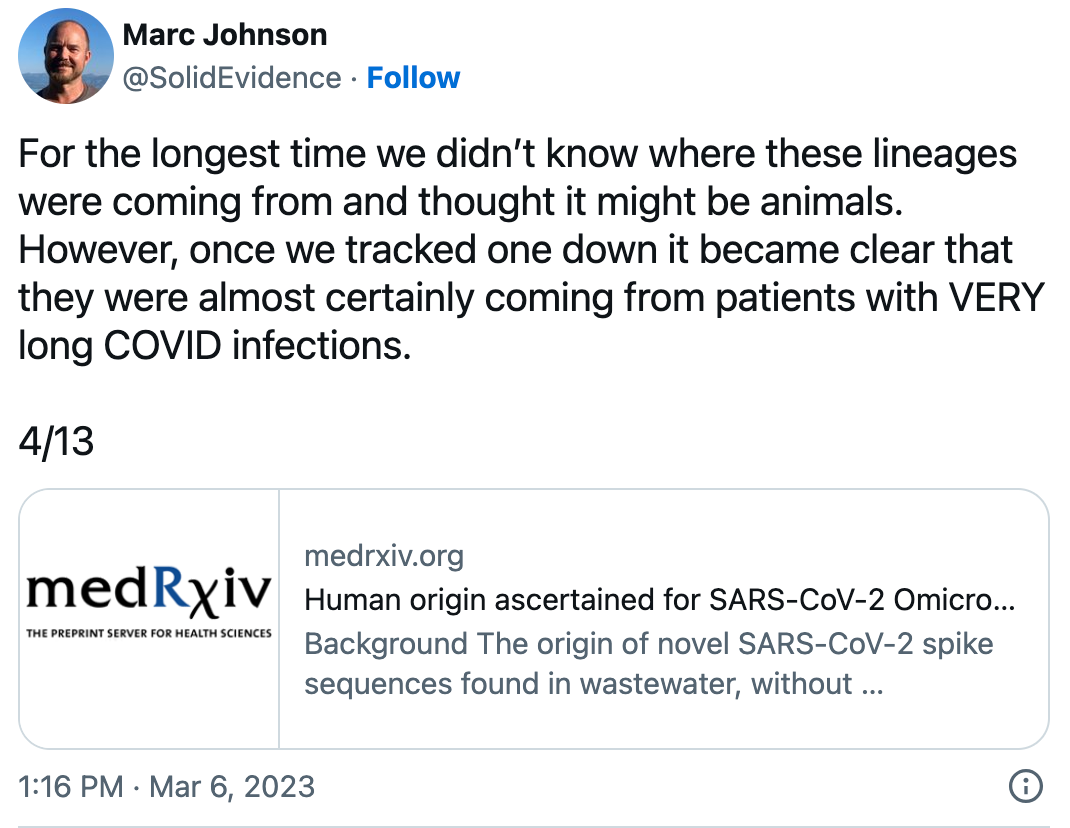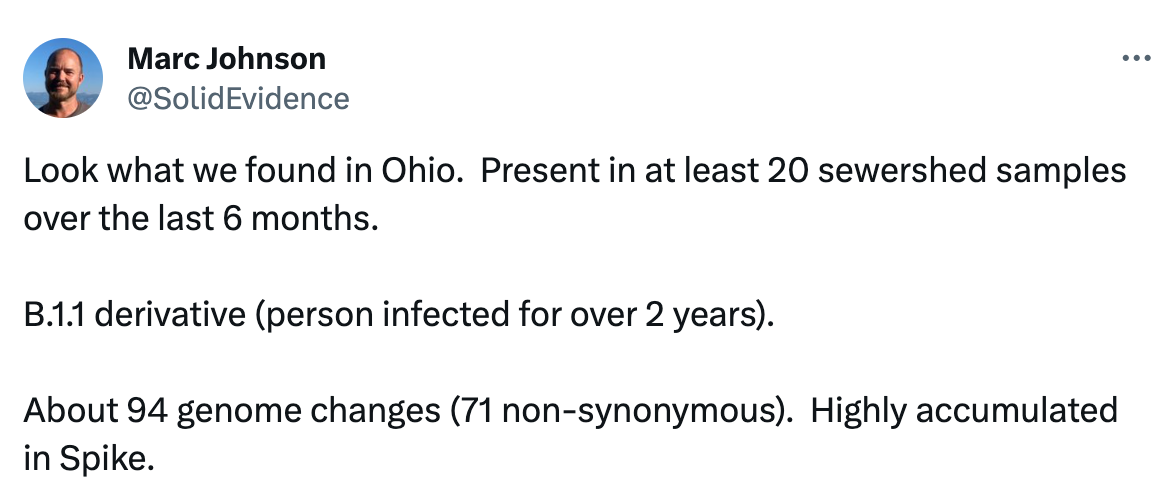Georeactor Blog
RSS FeedRevisiting the Cryptic Lineages
Resolving an epidemiology mystery from 2022
In 2018, researchers at U. Washington mailed kits to collect samples of the flu virus from volunteers in Seattle. In January 2020, the team realized they were in a position to study Covid-19, and ultimately beat the CDC to testing and notifying participants - that story was detailed in Nature in December 2021.
The Covid-19 pandemic accelerated genomic surveillance from the lab to regular clinics and even the sewers. UC Merced maintains a "CovidPoops19" world map of wastewater sampling sites. My home state (Illinois) maintains 79 test sites; this one covers a million people in my area.
This type of sampling was essential to studying how many people travel covid-positive, spread of covid between college dorms, and pre-emptively detecting polio in London and NYC.
Back in 2003, SARS-1 infamously spread in one building's janky plumbing, but sewer analysis picks up many fragments of inactive virus - it sounds gross but it's not spreading covid.
We never had this level of information for any virus before. We don't know how the flu "should" spread and mutate in a typical season. The scientific community is having new debates over who uploaded the first covid genome, whether early samples were deleted, whether it was ethical to sequence a sample from the Amy Coney Barrett event which infected then-president Trump.
Even though consensus is that outdoor transmission and surface transmission are rare, a jogger in Chongqing got blamed for spreading infecting dozens at a park, with sequencing proof, and dozens of New Zealanders caught covid from an elevator button. These mini mysteries hint that a run-in with a super-spreader is how many people get sick.
Cryptic lineages of New York City
This is all background for a mystery where I did a research deep dive recently - back in 2021, researchers detected four covid variants in NYC wastewater which never surfaced in regular covid swabs, anywhere - Tracking cryptic SARS-CoV-2 lineages detected in NYC wastewater.
The paper made Nature's Top 25 COVID-19 Articles of 2022, a headline in the New York Times - In New York City Sewage, a Mysterious Coronavirus Signal - and Syracuse.com's nasty New Covid variant may be spreading among rats in New York.
There was a particular interest in WNY4 because it had a mutation similar to Omicron (remember when everyone knew the names of variants…). The variants did not spread to other sewer-sheds, so the authors' hypotheses were:
- an animal population "with restricted movements or home ranges" (in the lab, the virus had some affinity to rodent cells)
- non-contagious infections [that] "predominantly replicate in gut epithelial cells and are not present in the nasopharynx"
- "patients confined to long-term healthcare facilities"
- strains somehow missed by publishing "consensus sequences"
Not considered: an underground cult, or some animal farm (either pets or traditional foods).
So here we are, two years later, and I wondered where these variants are now.
The Literature
Google Scholar found 137 citations of the paper. Most of the time, the citation is mixed in with other papers to introduce covid sequencing:
Finally, recent advances in computational analysis of wastewater samples allows for both clinically observed lineage and cryptic lineage detection, i.e., virus lineages that are not being detected in the human population but are still circulating - https://www.ncbi.nlm.nih.gov/pmc/articles/PMC10689440/
Or to base their research on these proven sequencing methods:
To confirm previous variant discrimination, Omicron-positive samples were sequenced using the technique published by Smyth et al. - https://www.sciencedirect.com/science/article/pii/S277270762300111X
Sometimes it's cited for basic facts?
SARS-CoV-2 RNA has been detected in wastewater in Australia and the USA. - https://www.sciencedirect.com/science/article/pii/S2772985023000546
A South Africa paper SARS-CoV-2 genomic surveillance in wastewater as a model for monitoring evolution of endemic viruses is closer to what I'm looking for - their own mystery lineages:
We also identified substantial prevalence of BA.3 and other Omicron BA.1-BA.2 recombinant lineages, including XE, XAD, and XAP, that were rarely observed in clinical surveillance during the study period.
The presence of uncommon mutations could be explained as "cryptic lineages" as described by Smyth and colleagues, which are thought to be attributed the cryptic lineages to either un-sampled, possibly chronic, infections or spillover of SARS-CoV-2 from an unidentified animal reservoir.
Then the paper Regional reemergence of a SARS-CoV-2 Delta lineage amid an Omicron wave detected by wastewater sequencing had a promising lead:
Cryptic lineages have been detected in wastewater before. Westcott et al. similarly observed a reemergence of a Delta variant in wastewater, isolated at a single WWTP and occurring three times in a timeframe of nine months. Gregory et al. described that the reservoir for these viruses could be one of three possible sources:
(1) one of non-human/animal origin,
(2) an asymptomatic group of infected persons or
(3) a group of immunocompromised persons.
The study by Shafer et al. described how they were able to track a cryptic lineage back to a group of approximately 30 people and pointed a immunocompromised individual with a persistent gastrointestinal infection out to be the point of transmission.
Finding Pooper Zero
The Shafer paper (originally Oct 2022, updated Sept 2023) is Human origin ascertained for SARS-CoV-2 Omicron-like spike sequences detected in wastewater: a targeted surveillance study of a cryptic lineage in an urban sewershed. It shares three authors with the NYC paper.
It started out with a baffling offshoot of an old strain:
In SARS-CoV-2 genomic surveillance using clinical specimens, B.1.234 viruses were detected in Wisconsin between September 2nd, 2020, and March 30th, 2021.
[...]
wastewater samples containing the cryptic lineage [were] collected between January 2022 and January 2023
They found the building:
By systematically sampling wastewater from targeted sub-sewershed lines and maintenance holes using compositing autosamplers, we traced this lineage (labeled WI-CL-001) to its source
[…] a single commercial building with approximately 30 employees.
To responsibly learn more about Pooper Zero:
The city, sewer plant, and locations of individual sampling sites have been concealed to protect the privacy of participants and residents. The authors representing the state public health authority had numerous conversations with the leadership of the identified source building in person and by phone, to explain the rationale for this investigation and describe the ways we would protect the identity of the company and employees. Specifically, we intentionally did not describe the investigation as a response to a known public health hazard, but rather as an activity to learn more about new technologies, and make sense of an unexpected finding that may someday be of public health significance. The wastewater findings were taken as a signal that people who work in the building may benefit from testing and linkage to care; once this testing was made available, we made it clear that the results would have the same privacy and confidentiality protections as all other testing.
[...]
19 out of approximately 30 employees provided samples
They did not identify and treat an individual, at least not in the published version of events:
none of the building occupants who volunteered for nasal swab testing organized by the local public health department were positive for SARS-CoV-2
So here is what we know about what they know:
our observations at both Facility Line B and Sub-District 5 are consistent with a persistently infected individual shedding very high amounts of SARS-CoV-2 RNA into wastewater at the source building
[...]
This is consistent with reports of individuals with prolonged SARS-CoV-2 infections, in whom weak immunity and persistent virus replication result in the selection of immune escape variants.
The authors cite two papers about new variants occurring in immunocompromised patients.
One possible benefit of knowing this, is that mutations from these persistent infections can predict the mutations that the wild virus may take in the future:
We therefore speculate that those two substitutions, or other mutations at these sites, may become more prevalent in circulating viruses in the future. Since we made this prediction in May 2023, the mutation V483∆ has arisen at the same residue in BA.2.86.
Bonus gross fact from the paper: your post-covid poop may contain (snippets of inactive) virus for months:
vRNA remained detectable in stool four months later in 12.7% of individuals even though all had cleared vRNA from the nasopharynx.
So, they solved it?
Within the limits of epidemiology and privacy, this seems like a win. One of the authors is now convinced this resolved the question of the original paper:

Meanwhile, someone in Ohio has been infected covid for 2+ years:

If you've been having GI problems after Covid, consider reaching out: https://twitter.com/SolidEvidence/status/1716900690797506661
Quick Disclaimer
This is a pilot project in exploring interesting bio / genetics research.
I do not have medical training, and this is not medical advice. As you can see, the researchers are still evaluating what this means, and the initial "animal reservoir" message was probably wrong.
I originally wanted to visualize everything on NextStrain and search NIH ( https://www.ncbi.nlm.nih.gov/datasets/taxonomy/2697049/ ) , but the names which the papers use (WNY1 - WNY4, WI-CL-001) are different from the IDs there. Seems like a privacy thing. There are some searchable IDs on the Wisconsin paper's GitHub repo.